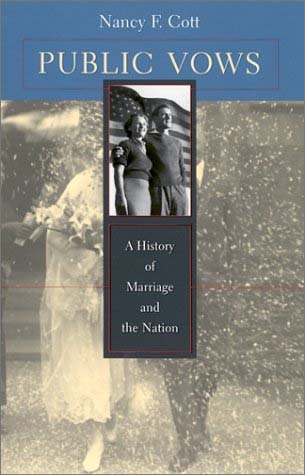
|
Public Vows: A History of Marriage and the Nation, edited by Nancy Cott, Harvard University Press, 2001 Paperback ISBN: 0674008758 (Click to order from Amazon.com) Hardcover ISBN: 0674003209 (Click to order from Amazon.com)
Indeed, in Cott's skillful hands, marriage becomes a master narrative for American political history writ large. She begins with the Revolutionary generation, noting that marriage resonated politically as "the prime metaphor for consensual union and voluntary allegiance [to the state], the necessary school of affection, and as the foundation of national morality" (21). From the very beginning, Cott argues, not all forms of marriage were equally valued-rather governmental officials supported monogamous, intraracial, and Christian marriage. Through the next century, Cott argues, polygamy was associated with despotism and coercion while monogamy was the thematic equivalency of political liberty and consent. But the relationship between marriage and the early republic was not only rhetorical. "The nation originally had few technologies of governance to monitor and control a people strewn all over a huge expanse of land," Cott writes. Marriages that "distinguished citizen-heads of households had enormous instrumental value for governance, because orderly families, able to accumulate and transmit private property and to sustain an American people, descended from them" (157). Slavery was also shaped by marriage, Cott continues. Just as African Americans could not consent to government, many nineteenth-century Americans believed, so they could not consent to marry. But slaveholders exercised vast control over slave family formation and reproduction. Later, marriage became one of the rhetorical touchstones in the slavery debate. Abolitionists pointed to the abuse of female slaves as evidence that slavery defamed marriage. Slaveholders responded, Cott states, by "domesticating slavery" through an argument that slavery and marriage were similar domestic relations in law. Women's rights activists understood this analogy in a different way than slaveholders, and used it as the basis for their critique of marriage. After the Civil War, ex-slaves were allowed to marry, and many did, understanding the "civil right manifest in marriage" (89). The Freedman's Bureau encouraged freedmen and women to marry and regulated the ways in which they did so. Civil War pensions were also determined by the template of marriage-rewarding husbands and fathers as providers. Cott's most interesting chapter deals with immigration policy, which was intertwined with marriage on several levels. Cott examines the changing legal codes that made a woman's citizenship dependent upon her husband's-from 1855 on, foreign women who married American citizens were automatically U.S. citizens; conversely, American women who married foreign men would lose their citizenship from 1907 until the passage of the Cable Act in 1922. Cott argues that prostitutes were featured in the first restrictive legislation because they undermined the central tenet that immigrants would "arrive freely in pursuit of healthy wages, monogamous marriage, household formation, and the achievement of the American standard of living." Cott also argues that ideas about marriage structured immigration policy more broadly. "In excluding prostitutes first, in structuring the literacy requirement to incorporate male citizens' privileges and obligations as heads of household, in rejecting Chinese and Japanese for defective morality and suspecting their marriages as subterfuges, immigration policy merged moral with political considerations and weighted marriage heavily in the balance" (155). Through all of this, Cott argues, marriage has not been a God-given or natural institution, but one shaped by legislatures and judges. Initially, there was very little national authority over marriage, and it was the informal public of neighbors and kin who exercised control over marital relationships. This led to great variation across the country, and underpopulated areas in the South and West especially had high rates of informal (common law) marital arrangements and self-divorce (desertion). In response, judges and states both moved in the early nineteenth- century to allow more people to perform marriage ceremonies. This was, Cott observes, "a way to draw more people into a set of obligations set by state law" (40). States would control not only the beginning but the end of marriage, Cott offers, and the antebellum period saw increased legal provision for divorce. Other mid-nineteenth century reforms-such as the married women's property acts and earning laws-gave married women more freedom. The increasing frequency of divorce after the Civil War led to greater federal intervention in marriage. The U.S. Congress encouraged monogamy among Indians, passed anti-obscenity laws, went after Mormon polygamists and targeted other communities (such as the Oneidas) that practiced alternatives to traditional marriage. By the late nineteenth century, Cott writes, the federal government had "crimped earlier flexibility towards marital practices" (126).
In the last half of the twentieth century, Christian marital monogamy has become "disestablished"-as with religion, the state no longer endorses one model of marriage. Since mid-century-shaped by increasingly liberal divorce laws and other legal reforms, the sexual revolution, and feminism-consent has replaced monogamy as the nation's guiding principle for intimate relationships. But, Cott concludes, examining the recent debates over same-sex marriage reveals that public authorities have not "granted the same imprimatur to every kind of couples' marriage" (215). When same-sex couples sued in Hawaii for the right to marry, they argued that conventional heterosexual marriage was just one of many "state-conferred" forms. That challenge led to the 1996 Defense of Marriage Act, which explicitly defined "marriage" and "spouse" in federal law. "Where public authorities a century earlier had been primed to defend Christian model monogamy from free love, interracial coupling, polygamy, self divorce, and commercial sex," Cott concludes, "now the Congress found heterosexuality the crucial boundary to maintain." Public Vows is a beautifully written, broad survey that very powerfully demonstrates the polity's long-standing stake in marriage. It will be of interest to GLBT scholars because it demonstrates the ubiquity of marriage-it has structured nearly every aspect of American life and continues to do so. Marriage is also coercive, but while minority groups and dissidents "feel the force of the law," the conforming (heterosexual) majority is scarcely aware of the "compulsion to be involved" (8). Finally, Cott takes an important first step to denaturalize marriage (and by extension heterosexuality) by showing how it has been continually manipulated by public authorities. But, unfortunately, it is only a first step. Heterosexuality remains strangely undertheorized and underexamined in Cott's history of marriage, and she never does tell readers exactly why heterosexual marriage has required so much support and regulation across the centuries. Even so, GLBT scholars will find Cott's work a useful resource as they seek to understand the state's role in shaping normative sexuality. Review Courtesy of the International Gay and Lesbian Review, ONE Institute Press, Los Angeles. http://www.usc.edu/isd/archives/oneigla/onepress/ This review, by Margot Canaday of the University of Minnesota, originally appeared in the Newsletter of the Committee on Lesbian and Gay History, issue Issue16/1 Spring 2002, and is reprinted with the permission of the Committee on Lesbian and Gay History at www.usc.edu/isd/archives/clgh online. |
 In her recent history of marriage, Public Vows, Nancy Cott builds on decades of scholarship by feminist historians who have worked to complicate the public-private dichotomy. Against those who have focused on marriage as a private intimate relationship, Cott argues that marriage is instead a hybrid of private and public, and she sets out to explore the myriad ways in which marriage is a public institution.
In her recent history of marriage, Public Vows, Nancy Cott builds on decades of scholarship by feminist historians who have worked to complicate the public-private dichotomy. Against those who have focused on marriage as a private intimate relationship, Cott argues that marriage is instead a hybrid of private and public, and she sets out to explore the myriad ways in which marriage is a public institution.
 Author Nancy F. Cott, Professor of History, Harvard University
Author Nancy F. Cott, Professor of History, Harvard University